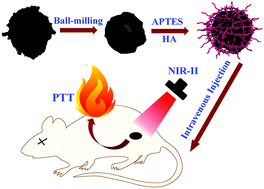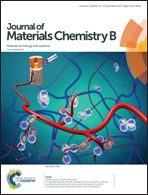Facile preparation of biocompatible Ti2O3 nanoparticles for second near-infrared window photothermal therapy†
Abstract
Photothermal therapy (PTT) is emerging as a powerful tool for the treatment of cancer. However, typical photothermal agents are excited by conventional near-infrared light (NIR-I, 700–900 nm), which leads to low tissue penetration and significantly hinders their further application. Compared with NIR-I light, the second NIR optical window light (NIR-II, 1000–1700 nm) can remarkably increase the tissue penetration depth; however, photothermal agents in this optical window are extremely limited and need to be further explored. Herein, we prepared Ti2O3 nanoparticles through a ball milling method, and to further improve their biocompatibility and targeting efficiency, the Ti2O3 nanoparticles were modified with hyaluronic acid. The as-prepared nanoparticles exhibited strong light absorption and excellent photothermal conversion efficiency in the NIR-II optical window. Both in vitro and in vivo studies clearly demonstrated that the Ti2O3@HA nanoparticles not only exhibit high biocompatibility and photostability, but also can be efficiently taken up by cancer cells and display excellent anticancer ability in the NIR-II region. Thus, this study provides a novel photothermal agent for PTT in the NIR-II optical window, which may further advance cancer photo-treatment in future.



 Please wait while we load your content...
Please wait while we load your content...